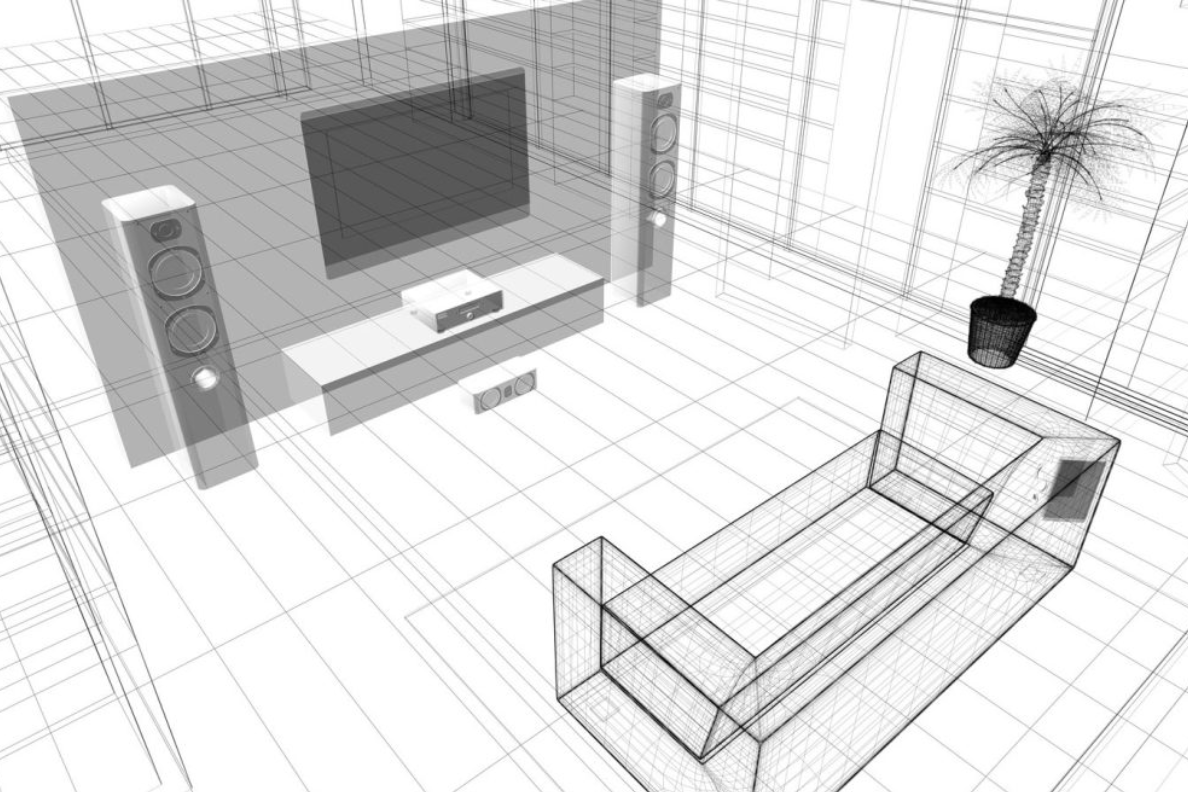
Related to dimensions, the sheer size will affect the integration plan. Smaller rooms, for example, may accentuate low frequencies, while larger spaces might provide a more balanced distribution of sound. In general, the bigger the space, the more speakers it will require, and the more power it may take to drive the speakers to fill the space with immersive sound at all targeted listening positions. But smaller space might sometimes also require more speakers to avoid the proximity effect and spread the sound in more locations.
Finally, integrators should pay attention to how the room is constructed. Wood? Gypsum? Concrete? The surfaces of walls, floors, and ceilings can either absorb or reflect sound waves. Excessive reflection can result in echoes and reverberation, negatively impacting the overall clarity of audio. On the other hand, too much absorption can lead to a dull and lifeless sound. Achieving the right balance through proper acoustic treatment, including the use of diffusers and absorbers, is essential for creating a well-controlled acoustic environment that enhances the immersive qualities of an audio system.
Quick point: For immersive audio especially, look up. A higher ceiling will help when installing “height” channel speakers. For one reason, it provides enough room to flexibly locate and configure those channels. For another, it ensures adequate distance between the height speakers and listeners to ensure a smooth sound in tandem with the room’s other channels.
Insight from RP22: Sometimes, a movie viewed in a home theater can be quieter than the home it’s viewed in. Therefore sound isolation is critical to an immersive audio experience to prevent excessive sound from getting into the space — and out. The wall, ceiling, and floor construction of the room go a long way to determining sound transmission loss (TL, in dB) at any given frequency, but so do the construction and location of doors, windows, ductwork, and more. Commonly, residential integrators must plan to isolate and reduce sound from HVAC equipment and other mechanical systems, based on the desired location of the room. RP22 offers extensive guidance, such as a suggested “lobby” to act as a sound gap.
Impact of Interior Design
Related to the construction of a room, its interior design can impact how sound interacts with the space. Carpets and rugs, for example, can absorb sound, reducing unwanted reflections and creating a more controlled acoustic environment. Hard surfaces like hardwood or tile, on the other hand, may contribute to more pronounced reflections.
Room layout and furniture placement also play a crucial role in shaping the immersive audio experience. Obstacles and reflective surfaces within the listening area —a bar, a coffee table, even a door depending on location — can impact sound diffusion and absorption. Thoughtful arrangement of furniture and décor items can help minimize acoustic challenges, contributing to a more immersive listening environment.
Also, pay attention to design touches in the room that may need to be treated, like a window dormer in an attic-like entertainment space or built-in shelving. Each affects sound transmission in a space. The integrator’s goal is to “remove” it from the soundscape through materials, treatments, sound reinforcement, etc. Consider engaging interior designers who deal in acoustically optimized designs.
Quick point: Meeting with the homeowner is especially important when understanding the impact of interior design. Many times, immersive audio performance comes down to seating. Common mistakes include positioning seats near the back wall or in a room’s null points. Ideally, the listening area also allows enough space to the left and right for optimal immersion and speaker localization.
Insight from RP22: Unlike actual cinemas, home theaters are relatively smaller spaces and more likely to be impacted by reflected sounds. Chairs, tables, walls, ceilings, equipment closets, ornamental touches, etc. all contribute to reflections that compete with direct sound. In addressing room acoustics, integrators want to achieve a suitable reverberation time (RT) while also treating the space for optimal reflection decay time (RdT). The challenge: keeping RdT low enough for optimal voice intelligibility while maintaining enough sound reflection to create that immersive experience.
AV Technology Suited to the Room
Notably, one of the most important room-specific technology decisions affecting immersive audio isn’t specifically about audio. Assuming the space will be used for home theater entertainment, residential integrators should work with homeowners to determine the desired video experience.
Based on psychoacoustics, much of an immersive audio experience is determined by front channels, so understanding what listeners will be looking at will go a long way toward determining how sound is delivered in the room. With a large flat-panel display, it can be straightforward to configure front and center channels. With a projection system, the integrator may (depending on the room layout) have the flexibility to position front channels behind an acoustically transparent screen. These days, video walls are a popular high-end design, but they can make integrating front speakers a challenge.
From there, considering room size, seating locations, and screen distance, it’s crucial to select speakers with enough SPL to cover the space with a smooth, even, immersive sound level (85dB nominal up to 105dB peak). Freestanding speakers work well, especially in the front and rear, provided there is enough room between them and nearby surfaces, like walls, to minimize reflections. If room construction accommodates them, in-wall and on-wall speakers make good surround speakers, reducing wall reflections and giving the room a cleaner look, but should be avoided in extreme locations such as in the wide channels positions due to off-axis response at the listener position. Use of speakers with angled tweeter would be recommended in such usage.
When it comes to height speakers, which are really what turns surround sound into truly immersive audio, a combination of angled, directional speakers installed above the listeners’ heads and down-firing in-ceiling speakers may be considered. The various immersive audio formats offer differing recommendations for the number and placement, so understanding the homeowners’ preferences is as important as the room itself.
Finally, subwoofers and low-frequency room optimization play a critical role in immersive audio and their use and position will be impacted by the room itself. A non-rectangular, more open entertainment space, for example, may need additional subwoofers of appropriate power to achieve even sound pressure throughout the listening area.
Quick point: In a bigger room, some combination of line-source and point-source speakers at the listener level may best achieve the desired immersive effect. Depending on the space to either side of the video system, line-source speakers are a good option for front channels, while point-source speakers make sense for side channels, nearer to the listener.
Insight from RP22: When it comes to projection screen installations, maintaining speakers at least 6 inches behind the screen can help minimize acoustic artifacts, and treating the area behind the screen can reduce any reflective sound that might originate there. In general, subwoofers shouldn’t go behind a screen.
Finally, the Importance of Calibration

Above all, a residential integrator should perform comprehensive room calibration to manage room modes, decay times, SPL, time and level adjustments, and more. Experienced calibrators can use their own tools and adjust the immersive audio system manually. Others may choose to run automated room treatment software to help determine optimal settings for the desired immersive experience.
In summary, assessing a room and integrating an immersive audio system comes down to the following:
- Define the room’s dimensions to determine optimal seating, screen, and speaker positioning.
- With those dimensions, pay extra attention to seating positions to avoid null points, specifying one or several rows as required.
- Define the video technology and screen size.
- Plan a speaker layout that suits the screen size, room size, and seating arrangement to include as necessary front, wide, surround, back, and ceiling speakers.
- Based on seating location and screen distance, determine the SPL each speaker should be capable of to achieve the room’s targeted SPL.
- Select the speaker technology/size based on earlier determinations and physical constraints.
- Study the best subwoofer locations based on a room mode study or use enough subwoofers for freedom of adjustment.
- Treat the room acoustically to obtain a smooth, linear RdT (0.2 to 0.5 seconds) across a frequency range of about 32 Hz to 8kHz.
- Use proper calibration tools to level and time-align the speakers.
- Time-align the subwoofers to achieve an even sound pressure in the listening area.
- Time-align the subwoofers to the front speakers to achieve a smooth transition.
- Define your target sound curve for the room and adjust the system accordingly.
- Run listening tests to validate that the room’s immersive audio performance meets the customer’s tastes. A future recommended practice from CEDIA will outline methodologies for measuring and validating audio performance in entertainment spaces.
As we’ve seen, room design can be nuanced and multifaceted. At the same time, it significantly influences the immersive qualities of an installed audio system. Therefore it’s important for residential integrators to understand such nuances, how they impact audio performance, and the best methods for overcoming the adverse effects. When something about a room risks “coloring” its intended sound, the integrator’s job is to remove it, through treatment or technology. And the ways to do so are as multifaceted as the design challenges they address.
For more detailed guidance, download CEDIA/CTA-RP22: Immersive Audio Design Recommended Practice.